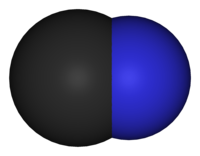Cyanide anion
 |
|
| Names | |
|---|---|
|
Systematic IUPAC name
Cyanide
|
|
| Identifiers | |
|
3D model (JSmol)
|
|
| ChEBI | |
| ChemSpider | |
|
PubChem CID
|
|
| UNII | |
|
|
|
|
| Properties | |
| CN− |
|
| Molar mass | 26.02 g·mol−1 |
|
Except where otherwise noted, data are given for materials in their standard state (at 25 °C [77 °F], 100 kPa).
|
|
| Infobox references | |
A cyanide is a chemical compound that contains the group C≡N. This group, known as the cyano group, consists of a carbon atom triple-bonded to a nitrogen atom.
In inorganic cyanides, the cyanide group is present as the anion CN−. For the salts such as sodium cyanide and potassium cyanide, these compounds are highly toxic. Hydrocyanic acid, also known as hydrogen cyanide, or HCN, is a highly volatile liquid that is produced on a large scale industrially. It is obtained by acidification of cyanide salts.
Organic cyanides are usually called nitriles. In nitriles, the CN group is linked by a covalent bond to carbon. For example in acetonitrile, the cyanide group is bonded to methyl (CH3). Because they do not release cyanide ions, nitriles are generally far less toxic than cyanide salts. Some nitriles, which occur naturally as cyanohydrins, release hydrogen cyanide.
In IUPAC nomenclature, organic compounds that have a –C≡N functional group are called nitriles. Thus, nitriles are organic compounds. An example of a nitrile is CH3CN, acetonitrile, also known as methyl cyanide. Nitriles usually do not release cyanide ions. A functional group with a hydroxyl and cyanide bonded to the same carbon is called cyanohydrin. Unlike nitriles, cyanohydridins do release hydrogen cyanide. In inorganic chemistry, salts containing the C≡N− ion are referred to as cyanides.
...
Wikipedia
